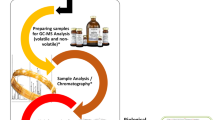Abstract
Application of matrix-assisted laser desorption ionization (MALDI) quadrupole time-of-flight (QTOF)-mass spectrometry (MS) to the determination of timiperone and estimation of its phase I metabolites were performed for the first time. The limit of detection of timiperone in human whole blood was 1 ng/mL with a quantitation range of 2–100 ng/mL using 20 μL each of whole blood. The developed method was successfully applied to the determination of timiperone in whole blood obtained from a deceased subject that had a history of timiperone treatment. The concentration of timiperone in whole blood of the victim was 3.98 ng/mL. Moreover, the MALDI-QTOF-MS/MS method was also used for detection of new metabolites of timiperone in urine also obtained from this victim. Five new metabolites were detected, which were formed via exchange of S for O, deletion of S, carbonyl reduction, hydroxylation, and a combination of them. Most likely, some of the newly detected metabolites seem pharmacologically active because they retain butyrophenone structures.





Similar content being viewed by others
References
Kudo K, Ishida T, Hikiji W, Usumoto Y, Umehara T, Nagamatsu K, Tsuji A, Ikeda N (2010) Pattern of poisoning in Japan: selection of drugs and poisons for systematic toxicological analysis. Forensic Toxicol 28:25–32
Tachizawa H, Sudo K, Sasano H, Sano M (1981) Disposition and metabolism of timiperone in the rat, dog, and monkey. Drug Metab Dispos 9:442–448
Hattori H, Suzuki O (1986) Positive- and negative-ion mass spectrometry of butyrophenones. J Chromatogr 382:135–145
Hoja H, Marquet P, Verneuil B, Lotfi H, Dupuy JL, Pénicaut B, Lachâtre G (1997) Determination of haloperidol and its reduced metabolite in human plasma by liquid chromatography-mass spectrometry with electrospray ionization. J Chromatogr B Biomed Sci Appl 688:275–280
Aoki Y, Hakamata H, Igarashi Y, Uchida K, Kobayashi H, Hirayama N, Kotani A, Kusu F (2009) Simultaneous determination of azaperone and azaperol in animal tissues by HPLC with confirmation by electrospray ionization mass spectrometry. J Chromatogr B Biomed Sci Appl 877:166–172
Seno H, Hattori H, Ishii A, Kumazawa T, Watanabe-Suzuki K, Suzuki O (2000) Analyses of butyrophenones and their analogues in whole blood by high-performance liquid chromatography-electrospray tandem mass spectrometry. J Chromatogr B Biomed Sci Appl 746:3–9
Gradinaru J, Vullioud A, Eap CB, Ansermot N (2014) Quantification of typical antipsychotics in human plasma by ultra-high performance liquid chromatography tandem mass spectrometry for therapeutic drug monitoring. J Pharm Biomed Anal 88:36–44
Korpi ER, Kleinman JE, Costakos DT, Linnoila M, Wyatt RJ (1984) Reduced haloperidol in the post-mortem brains of haloperidol-treated patients. Psychiatry Res 11:259–269
Tachizawa H, Sudo K, Sano M (1979) Effect of timiperone on 3H-spiroperidol binding to rat striatal dopamine receptors. Eur J Pharmacol 59:245–251
Shimoda K, Shibasaki M, Inaba T, Cheung SW, Someya T, Takahashi S (1998) Carbonyl reduction of timiperone in human liver cytosol. Pharmacol Toxicol 83:164–168
Shimoda K, Someya T, Morita S, Hirokane G, Yokono A, Shibasaki M, Takahashi S (1998) Plasma concentrations of timiperone and its reduced metabolite in the patients on timiperone. Psychiatry Clin Neurosci 52:535–540
Celardo A, Bonati M (1990) Determination of thiopental measured in human blood by reversed-phase high-performance liquid chromatography. J Chromatogr B Biomed Appl 527:220–225
Castaing N, Benali L, Ducint D, Molimard M, Gromb S, Titier K (2011) Suicide with cisatracurium and thiopental: forensic and analytical aspects. J Anal Toxicol 35:375–380
Pianotti R, Lachette S, Dills S (1986) Desulfuration of cysteine and methionine by Fusobacterium nucleatum. J Dent Res 65:913–917
Kudo K, Ishida T, Hikiji W, Hayashida M, Uekusa K, Usumoto Y, Tsuji A, Ikeda N (2009) Construction of calibration-locking databases for rapid and reliable drug screening by gas chromatography–mass spectrometry. Forensic Toxicol 27:21–31
Author information
Authors and Affiliations
Corresponding author
Ethics declarations
Conflict of interest
There are no financial or other relations that could lead to a conflict of interest.
Ethical approval
All procedures performed in studies involving human participants were in accordance with the ethical standards of the international and/or national committee and with the 1964 Helsinki declaration and its later amendments or comparable ethical standards. Informed consent was obtained from all individuals included in the study, who supplied about 1 mL each of blood and urine for use as blank samples. The analysis of toxic substances from the cadaver was permitted by judicial authorities with an official document.
Rights and permissions
About this article
Cite this article
Nozawa, H., Minakata, K., Yamagishi, I. et al. Application of MALDI-QTOF mass spectrometry to the determination of timiperone in whole blood, and estimation of its new metabolites in urine of a deceased subject who had been treated with timiperone antemortem. Forensic Toxicol 34, 363–371 (2016). https://doi.org/10.1007/s11419-016-0323-z
Received:
Accepted:
Published:
Issue Date:
DOI: https://doi.org/10.1007/s11419-016-0323-z




